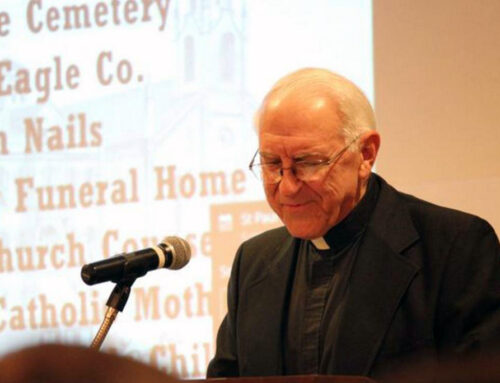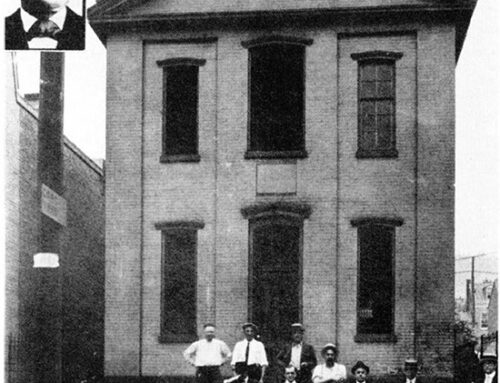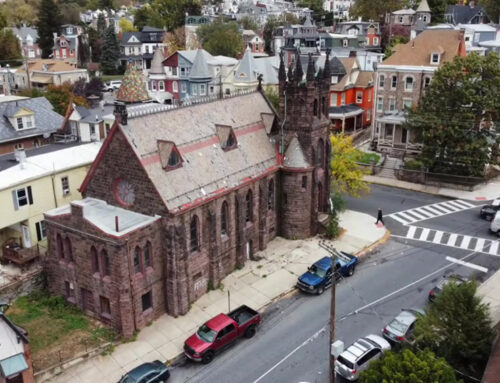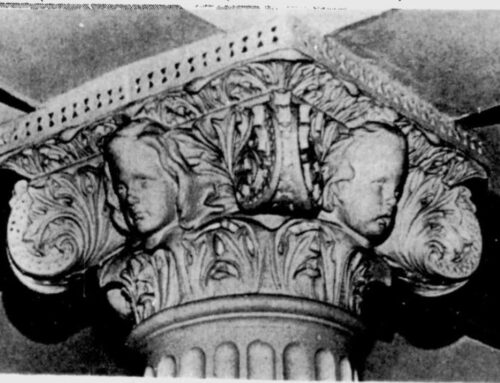In 1920, St. Joseph’s Church, 8th and Spring Streets, was the only Catholic Church in Reading north of Walnut Street. To accommodate the growing population in the northwest section of the city, Archbishop (later Cardinal) Dennis Dougherty, established St. Margaret’s Parish on February 8th, and appointed Father Edward F. X. Curran its founding Pastor.
The boundaries of the new parish extended as far north as Leesport, east to the Reading Railway, south to Buttonwood Street and west to the Schuylkill River. Two hundred families made up the charter members.
Father Curran took up temporary residence in St. Joseph’s Rectory and immediately obtained a lease from the Royal Theatre (since demolished) on the southeast corner of Church and Spring Streets. It was here the pioneering new parishioners worshipped for two years, sacrificing for the day when they would have a permanent parish church.
On March 13, 1920, the property at 1012 North 5th Street was purchased for the original rectory, where weekday Masses were offered, confessions heard, and Baptisms and Weddings were celebrated. Soon afterwards a farmland on the north side of Spring Street between Centre Avenue and Third Street, comprising 68,081 square feet, was purchased for $55,000. Here in September, 1920, construction began on a basement church and school.
On Easter Sunday, April 16, 1922, Father Curran celebrated the first Mass in the long-awaited basement church of St. Margaret. The Sunday chapel in the Royal Theatre was happily history. In addition to the space for Mass – the altar, sanctuary located on the present stage – four classrooms divided by curtains were set up on the east and west sides of the building. Here in September, 1922, St. Margaret School was opened, staffed by the Sister Servants of the Immaculate Heart of Mary. The sisters established their convent in a leased property at 1023 North Front Street.
With the priests on 5th Street, the sisters on Front Street and dedicated parishioners working with them, all looked forward to the completed upper structure of the combination church-school building. The stressful labors proved too much for the health of the parish’s founding pastor, Father Curran, and in February, 1924, he was granted a sick leave, much to the sorrow of his loyal flock. He was succeeded by Father William McShain.
Two years later, on April 11, 1926, Bishop Michael Crane, Auxiliary Bishop of Philadelphia, blessed the new upper church. The new building was erected over the former basement church. The basement was converted to a social center, services being held on the first floor of the new superstructure. On the second floor were four class rooms and four other rooms, which were used as an apartment for the five sister teachers of the parish school, members of the Order of Sisters, Servants of the Immaculate Heart of Mary.
Below: Combination Church/School.

In November of 1926 workers started excavating on the plot of land next to the church/school superstructure for the construction of a new rectory. The rectory was completed in 1927.
Below: Rectory (1927).

The latter years of the 20’s were difficult ones for the parish struggling to meet the tremendous debt on all the construction. The enterprising parishioners even constructed a miniature golf course at the corner to raise funds, but this valiant attempt failed. Father McShain traveled to other churches in the Diocese appealing for help. These were indeed bleak times but their strong faith supported them. A new pastor, Father John Fealey, succeeded Father McShain in February of 1931, but his health could not bear the strains of the times, and he died on November 26, 1931 at age 42.
Father McShain was succeeded by Father Edward Devine in December of 1931. Parish membership was increasing rapidly now, but these were the Depression years and the financial problems grew worse. In 1935, in an attempt at increased revenue, the parish leased the corner property to an oil company to locate a service station. However, area residents filed an injunction restraining the oil company from proceeding with its plans, claiming the neighborhood to be a residential section. The case went to court and in April 1937, the Court upheld the residential area claim and forbade the service station. The decision turned out to be Providential. A few years later, an anonymous donor financed the building of the beautiful shrine of Our Lady of the Miraculous Medal on the church property, dedicated on Sunday, August 14, 1938. Instead of an unsightly gas station, we now have one of the beauty spots of the City of Reading. The shrine followed the introduction of the first Perpetual Miraculous Medal Novena Devotions by Father Devine in 1933. In a few years the Novena was held three times every Monday attracting as many as 1,500 persons on many days. Monsignor (later Bishop) Fulton J. Sheen was one of the early preachers of the Novena.
In June, 1942, after 11 productive years at St. Margaret, Father Devine was transferred and was succeeded by Father Raymond J. O’Donnell, who became the parish’s fifth Pastor. During the World War II years, the parish continued to grow as did the school enrollment. New classrooms were needed. In 1947, the parish, greatly aided by a generous bequest from the estate of James J. O’Rourke, a prominent charter member of St. Margaret, purchased the former Bausher property at 935 Centre Avenue, which was converted into a convent for the Sisters.
Below: 935 Centre Ave. (Former Convent).

For almost 20 years, the Sisters’ quarters were in the school, and this part of the building was now converted into additional classrooms. On May 25, 1954, Father O’Donnell and his parishioners celebrated the burning of the mortgage on all church properties at a dinner in the Abraham Lincoln Hotel. The parish was finally debt free – – temporarily.
After 14 years at St. Margaret, Father O’Donnell was transferred in 1956. He was succeeded by Father A. Bennet Conway, formerly Pastor of Holy Family Parish, New Philadelphia. The parish had now grown considerably with 1,200 families listed in 1960, and 425 students in the school.
In September, 1960, Father Joseph Hartley became the new pastor. Foreseeing the need for a larger church, he purchased in June, 1963, two properties on Centre Avenue: the Bausher Estate at 925 Centre Ave. and the Fegley property at 957 Centre Ave.
Below: 957 Centre Ave. (Present Church).

Later that summer, the priests moved into the former Bausher Home and the old rectory became the convent for the sisters. Demolition of the old convent at 935 Centre Avenue and the newly-acquired Fegley property on the corner began shortly thereafter.
The Bausher residence at 925 Centre Ave. was the former home of Solon D. Bausher, owner of many textile mills in the Reading and Berks County area. The home was constructed in 1920 at a cost of about $75,000.
Below: 925 Centre Ave., front (Former Bausher Residence, present rectory) – Touch or Click Images to Enlarge.
On September 24, 1964, Father Hartly died in Reading Hospital. In December, 1964, Father Andrew Lenahan became Pastor. At this time, the 2nd Vatican Council was coming to a close, and it was during Father Lenahan’s pastorage that the many decrees of the Council affecting parish life were introduced. But Father Lenahan’s primary task, with the able assistance of Father Joseph Fricker, Administrator, was overseeing the construction of the magnificent new church. The new Church was completed in 1970.
Below: St. Margaret’s Church (2015).

Below: St. Margaret’s Church (2015).

In 1972, a Reading native and Central Catholic graduate, Father John Auchter, replaced Father Fricker as Administrator under Father Lenahan and was soon after named the ninth Pastor of St. Margaret. With the help of many dedicated parish volunteers, Father Auchter set aside a portion of the church basement as a beautiful chapel for Daily Mass. Father also initiated the all-day Exposition of the Blessed Sacrament in the basement chapel each Monday of the year.
In 1983, Father Edward Sacks succeeded Father Auchter as Pastor. In his brief two-year tenure as Pastor, Father Sacks welcomed the first Permanent Deacons to serve the parish: Rev. Mr. John Hozza in 1983, Rev. Mr. Thomas Hundele in 1985, and Rev. Mr. John Konepelski in 1983. These ordained husbands and fathers brought new insights to Marriage and Baptism Preparation Classes along with many liturgical services to the parish. Deacon Hozza gave faithful service to the parish until his death in 1992.
The parish welcomed another new pastor in 1985: then former neighbor as Pastor of St. Paul’s Church, Monsignor William Handges. For the first time, the parish had Pastor who was a domestic Prelate. After nine years of dedicate service to St. Margaret, Msgr. Handges was transferred in 1994 to St. Anthony’s Parish, Easton.
Father Frances Gillespie was next to serve as pastor until June 1996. He was ably assisted by Father Michael Ahrensfield, Father Edward Essig and Deacon John Konopelski. Father Francis Schoenauer succeeded Father Gillespie in June of 1996 and served the St. Margaret Parish until June 2002.
Father John Gibbons came to St. Margaret in 2002 after serving as assistant Pastor at St. Ignatius Loyola in Whitfield, PA. Father Gibbons has brought his unique exuberance to both the Parish and the School. He is assisted by Father Thomas Gleeson on the weekends and Deacon John Konopelski, Deacon Ramon Rolon and Deacon Gregory Schneider.
In 2014 Rev. Angel L. Garcia was appointed administrator of St. Margaret Church.








Leave A Comment